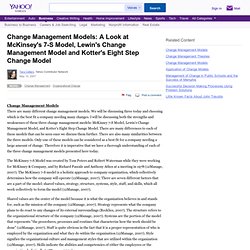

Lewin's Change Management Model - Change Management Training from MindTools. Understanding the Three Stages of Change Find out about Lewin's Change Management Model, in this short video.

Change is a common thread that runs through all businesses regardless of size, industry and age. Our world is changing fast and, as such, organizations must change quickly too. Organizations that handle change well thrive, whilst those that do not may struggle to survive. The concept of "change management" is a familiar one in most businesses today. One of the cornerstone models for understanding organizational change was developed by Kurt Lewin back in the 1950s, and still holds true today. Understanding Lewin's Model If you have a large cube of ice, but realize that what you want is a cone of ice, what do you do? By looking at change as process with distinct stages, you can prepare yourself for what is coming and make a plan to manage the transition – looking before you leap, so to speak.
Unfreeze This first part of the change process is usually the most difficult and stressful. Brief History of Change: Lewin - LeaderLab. Www.itim.org/articleonchangemanagement.pdf. Lewin's Force Field Analysis Explained. Kurt Lewin's Force Field Analysis is a powerful strategic tool used to understand what's needed for change in both corporate and personal environments.

Best of all - it's easy to use and has complete credibility as a professional tool. We'll use a little basic science to introduce the concept, after which you'll find enough information to allow you to unleash your knowledge of force fields on colleagues! You can download this free Application Tool when you're ready. You will need Adobe Reader to open the file. The Concept Let's start with a simple science experiment (this really is relevant, so stay with me for a moment please).
You'll need to sit down for this one. Well, there are two answers really. The other is the chair itself, which provides an opposing force, pushing up against gravity, and stopping you falling to the ground. So it would seem that while you are sitting you're in an equilibrium of sorts. Two forces keep you there. Agreed? May the Force be with you, or against you. Www.cemerdemir.com/ManageChange.pdf. Change Theory by Kurt Lewin. Change Management Models: A Look at McKinsey's 7-S Model, Lewin's Change Management Model and Kotter's Eight Step Change Model. Change Management Models There are many different change management models.

We will be discussing three today and choosing which is the best fit a company needing many changes. I will be discussing both the strengths and weaknesses of these three change management models: McKinsey 7-S Model, Lewin's Change Management Model, and Kotter's Eight Step Change Model. There are many differences to each of these models that can be seen once we discuss them further. There are also many similarities between the three models. The McKinsey 7-S Model was created by Tom Peters and Robert Waterman while they were working for McKinsey & Company, and by Richard Pascale and Anthony Athos at a meeting in 1978 (12Manage, 2007).
Shared values are the center of the model because it is what the organization believes in and stands for, such as the mission of the company (12Manage, 2007). There are many benefits and disadvantages of the McKinsey Model. HSE. Kotter 8-Step Change model. Change Management Blog: Change Model 3: John Kotter's 8 Steps of Leading Change. Background: For leaders of organizations, managing change is an important strategic task.

In the last ten years, there have been numerous studies which all confirmed that between 60-80% of all change projects fail fully or partly: either the objectives of the project are not achieved or the projects cannot be completed in time or on budget. Usually, a lot is at stake: money, personal reputation, and the health of the organization. So, the 1 million dollar question for any change leader is: How can I make sure that my change project is successful?
John Kotter, one of the leading management thinkers and writes has given his answer to this question by providing an eight step model for leading change. Originator of the Model: John Kotter, his book "Leading Change" (1996) Phases of the Change Process (taken from strategicconnections.com): Applicability: Does the Model Relate to Complexity Theory? No.